
Modular synthesizers are synthesizers composed of separate modules for different functions. The modules can be connected together by the user to create a patch. The outputs from the modules may include audio signals, analog control voltages, or digital signals for logic or timing conditions. Typical modules are voltage-controlled oscillators, voltage-controlled filters, voltage-controlled amplifiers and envelope generators.
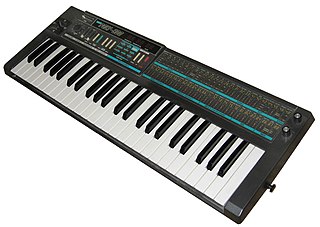
The Korg Poly-800 is an 8-voice analog synthesizer released by Korg in 1983. Its initial list price of $795 made it the first fully programmable polyphonic synthesizer that sold for less than $1,000. It was designed for portability, featuring battery power and a lightweight design that allowed the user to play with it strapped around their neck. It utilized digitally controlled oscillators (DCOs), and was a paraphonic synth with a single filter shared between its eight voices.
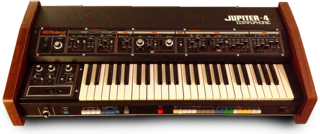
The Roland Jupiter-4 (JP-4) was an analog synthesizer manufactured by the Roland Corporation between 1978 and 1981. It was notable as the company's first self-contained polyphonic synthesizer, and for employing digital control of analog circuits, allowing for such features as programmable memory, voice assignment modes, an arpeggiator, polyphonic portamento and others.

The Korg MS-20 is a patchable semi-modular monophonic analog synthesizer which Korg released in 1978 and which was in production until 1983. It was part of Korg's MS series of instruments, which also included the single oscillator MS-10, the keyboardless MS-50 module, the SQ-10 sequencer, and the VC-10 Vocoder. Additional devices included the MS-01 Foot Controller, MS-02 Interface, MS-03 Signal Processor, and MS-04 Modulation Pedal.
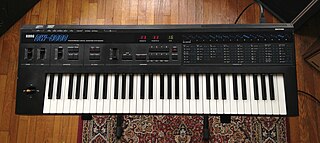
The Korg DW-8000 is a polyphonic hybrid digital-analog synthesizer released in 1985. It blends digital waveforms with an analog filter and amplifier, followed by a digital delay for adding echo effects. It boasts eight-note polyphony and its keyboard is equipped with velocity sensitivity and aftertouch.

The Korg Prophecy is a monophonic synthesizer released by Korg in 1995. one of the earliest commercial DSP physical/acoustic and analog "virtual" modeling sound synthesizers and Korg's first monophonic synthesizer since the Mono/Poly. The Prophecy employs Korg's Multi Oscillator Synthesis System (MOSS), which features digital oscillators capable of emulating synthesis techniques such as analog synthesis, FM and physical modelling. Emphasized for its portability, expressiveness, and engaging playability, a distinctive feature of the Prophecy is its multifunctional Wheel 3, nicknamed the 'log'.
The Korg Poly-61(PS-61) is an analog synthesizer manufactured by Korg between 1982 and 1986. It was the first affordable synthesizer to feature two oscillators per voice, and was Korg's first synthesizer to feature digitally-controlled analog oscillators (DCOs). The Poly-61 marked a significant departure in design philosophy from previous Korg synthesizers by replacing the traditional array of dedicated control knobs on the front panel with a digital interface that required users to select parameters individually for adjustment.
The Korg Polysix(PS-6) is a six-voice polyphonic analog synthesizer released by Korg in 1981. It was one of the first affordable polyphonic synthesizers on the market, and was released as a cheaper alternative to the Sequential Prophet-5 and Oberheim OB-X, priced at approximately a third of the cost of its contemporaries in the polysynth market. It includes one VCO per voice, enhanced by a chorus/ensemble effect for added richness. It also comes equipped with 32 program memories and an integrated arpeggiator.

The Korg MS2000 is a virtual analog synthesizer produced by the Japanese electronic musical instrument manufacturer Korg.

Korg MS-10 is an analogue synthesizer created by Korg in 1978. Unlike its bigger brother, the Korg MS-20, the MS-10 only has one VCO, one VCF and one envelope generator. It is monophonic and has 32 keys.

The Korg DSS-1 is a polyphonic sampling synthesizer released by Korg in 1986. As Korg's initial entry into the sampling market, the DSS-1 combines sampling, additive synthesis, and waveform drawing with an analog signal path. The DSS-1 was released a time when major synthesizer manufacturers like Yamaha and Casio were beginning to explore sampling, an area of sound design dominated by companies like Fairlight, E-mu, and Ensoniq. Korg did not stay long in the sampling arena; the DSS-1 was the company's only sampler until 1998 when Korg introduced sampling options on their Triton and Trinity series of workstations.

The Evolver is an analog-digital hybrid synthesizer designed by Dave Smith and manufactured by Dave Smith Instruments. It was first released as a desktop version in 2002, then later a 37-key keyboard bearing the same synth engine as the Evolver desktop was also released. A polyphonic version of the Evolver, dubbed the Poly Evolver, was released in 2004 as a rackmount version, then a 61-key keyboard version of the Poly Evolver was released in 2005. The Evolvers were replaced by new high end models, the Prophet 12 and the Pro 2.

The Prophet '08 is a polyphonic analog synthesizer released by Dave Smith Instruments (DSI) in 2007. As with DSI's other instruments, the Prophet '08 uses analog subtractive synthesis. Similar in functionality to the renowned Sequential Circuits Prophet-5 popularized in the 1970s, the Prophet '08 has an all analog signal path; however its envelopes are generated digitally.
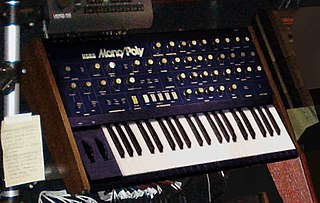
The Korg Mono/Poly (MP-4) is a paraphonic analog synthesizer released by Korg in 1981, bridging the gap between monophonic and polyphonic synthesis. Released in the same year as the Korg Polysix, as a complementary synth, The Mono/Poly is equipped with four VCOs and can operate as a four-voice paraphonic synth with limited capabilities, or as a monophonic synth using all four oscillators. Upon its release, it was the only monophonic synthesizer with an integrated quad-VCO design available on the market.

The AX80 is a polyphonic analogue keyboard synthesizer manufactured by Akai Professional in 1984. It was Akai's first venture into the professional electronic musical instrument market. The AX80 used digitally controlled oscillators (DCO) and filter circuitry based on the Curtis Electronics CEM 3372 integrated circuit. It was marketed as part of a line of project studio equipment called the Akai Music Studio System, which included the S612 digital sampler the MR16 drum machine, the MS08 sequencer, and the MG1212 multitrack tape recorder, at a price of $1,695 US.

The AX60 is a polyphonic analogue keyboard synthesizer manufactured by Akai Professional in the mid-1980s. It was Akai's answer to the popular Roland Juno series synthesizers. The AX60 uses voltage-controlled analogue oscillators and filter circuitry based on the Curtis Electronics CEM 3394 integrated circuit.

The CZ series is a family of low-cost phase distortion synthesizers produced by Casio in the mid-1980s. Eight models of CZ synthesizers were released: the CZ-101, CZ-230S, CZ-1000, CZ-2000S, CZ-2600S, CZ-3000, CZ-5000, and the CZ-1. Additionally, the home-keyboard model CT-6500 used 48 phase distortion presets from the CZ line. The CZ synthesizers' price at the time of their introduction made programmable synthesizers affordable enough to be purchased by garage bands. Yamaha soon introduced their own low-cost digital synthesizers, including the DX-21 (1985) and Yamaha DX100, in light of the CZ series' success.

The Korg Z1 is a digital synthesizer released by Korg in 1997. The Z1 built upon the foundation set by the monophonic Prophecy released two years prior by offering 12-note polyphony and featuring expanded oscillator options, a polyphonic arpeggiator and an XY touchpad for enhanced performance interaction. It was the world's first multitimbral physical modelling synthesizer.

The Korg Minilogue is a polyphonic analog synthesizer released in 2016 by Korg. It offers users four-voice polyphony with two analog VCOs per-voice and was designed to be affordable. It was designed by Korg engineer and synthesizer designer Tatsuya Takahashi, who said "the concept of the Minilogue was to build an analog synthesizer that doesn't rely on the fame and success of an old synth".
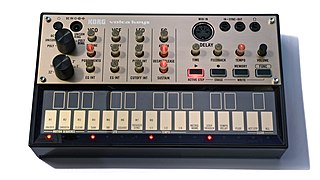
The Volca Keys is a analogue synthesizer manufactured by the Japanese music technology company Korg. It was announced in April 2013 at MusikMesse and was at the time one of the few affordable analogue synthesizers available. The Volca Keys uses subtractive synthesis to create sounds and is three-note paraphonic, meaning that it can play chords with all voices sharing a single voltage-controlled filter (VCF).



















